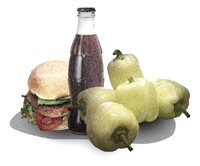Finding your own delicate balance
Balance is essential to a healthy lifestyle – and nutrition is no exception to that rule.
With the rising interest in raw food diets, health experts everywhere are looking into the advantages and disadvantages of cooked versus raw foods.
Cooked food has many benefits. Cooking tomatoes, for example, increases their antioxidant potency by five or six times compared to eating them raw. Cooking carrots breaks down the cell wall, which also allows us to absorb the nutrients more easily. In addition, steaming and baking foods, particularly starchy foods such as potatoes, can make them easier to digest.
However, there are also dangers to cooking foods at very high temperatures.
Health Canada reports that cooking food at extremely high temperatures produces acrylamide, a chemical compound known to cause cancer. Higher amounts of acrylamide have been found in both fried and deep-fried foods, while baked goods such as breads and cereals have significantly decreased levels of acrylamide to trace amounts.
Raw foods have their disadvantages, though, too. Proteins and starches can be much more difficult for the stomach to process when they are uncooked. Also, raw animal products can contain harmful bacteria if they are not handled appropriately. The health dangers associated with the bacteria need to be taken into consideration when eating a largely raw diet.
Most raw foods are high in carbohydrate or fat, so ensuring that your diet includes adequate amounts of protein can also be a concern.
Sprouting is a popular way to get high quality nutrients from plant-based foods. Sprouts such as alfalfa, clover and bean are all common sources of protein in a raw food diet. Because the composition of the food is changed by sprouting, the nutrients are made far more available for absorption in the body. Regardless of whether your diet consists of mostly cooked or mostly raw foods, everyone can greatly benefit from introducing sprouts into their diet.
You can buy pre-made sprouts at the store in the produce section for only two or three dollars per package.
Or you can try making them yourself at home: place the desired amount of seeds, grains, nuts or legumes that you want to sprout into a jar, add cold water nearly halfway to the top of the jar and let it sit for several days. Drain the water, rinse the contents and refill the jar with fresh water a few times each day.
Sprouts are delicious additions to salads and sandwiches.
Light steaming is an excellent way to ensure that we retain the nutrients in the foods that we eat.
Boiling, although it is a popular cooking technique, substantially decreases the nutritive value of the food that is being made.
Our healthiest choices for cooking foods are steaming, baking or stir-frying with only a small amount of oil.
Eating foods raw or cooked each have advantages. Consuming a variety of both raw and cooked foods is the healthiest way to increase our body’s absorption of nutrients.
University of Winnipeg student Sagan Morrow writes a health and wellness blog. Check it out at http://www.livingintherealworld.net/healthy/.
Published in Volume 64, Number 16 of The Uniter (January 21, 2010)







